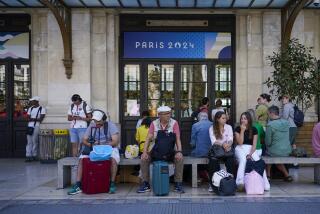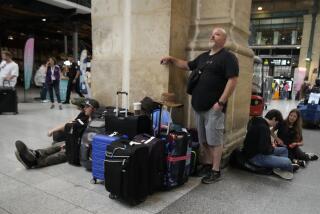French Rail Chief Quits After 2nd Fatal Crash in Paris
- Share via
PARIS — The president of France’s state-run railroad resigned Sunday after the second fatal train crash in six weeks. The government blamed the crash in part on a failure to implement measures ordered after an earlier wreck.
Unions blamed the government for Saturday’s crash and accused it of skimping on safety to save money. It said that the resignation of Philippe Rouvillois, who had been railway president six months, would only camouflage the problem.
Transport Minister Michel Delebarre said that Rouvillois, 53, offered his resignation and that he has accepted it.
Slammed Into Barrier
A 29-year-old man was killed and 57 people were injured Saturday when a four-car passenger train crashed into the barrier at the end of the track in Paris’ Gare de L’Est station.
Seven of the injured remained hospitalized Sunday, none of them in a life-threatening condition, hospital officials said.
An initial investigation indicated that the cause of the crash was mechanical and not human error.
On June 27, a train crash at another Paris station, the Gare de Lyon, killed 56 people and injured 32.
The two major accidents and several minor incidents have heightened concern about safety on the railroads.
On Saturday night, Delebarre said that instructions given by the government after the June 27 crash had not been adequately followed.
Guidelines Not Followed
“I don’t believe in fate,” he said. “As minister of transport and maritime affairs, I note that the safety instructions given on July 20 to the (railroad) board of directors . . . remain still insufficiently followed up.”
Those measures included stricter checks on braking equipment, more training of mechanics on brake equipment and installation of telephone links between passenger cars and the engineer. The June 27 crash was blamed on brake failure.
Officials of the railway, Societe Nationale des Chemins de Fer, or SNCF, said the train’s conductor told them he noticed nothing unusual during his run from Chateau Thierry, 60 miles northeast of Paris, until he entered the Gare de L’Est. Then, he said, the brakes did not respond.
A review of the train’s “black box” recorder indicated that the engineer correctly braked and that a slowing of the train occurred, the company said. But the recording showed that while braking was normal, the engine, located at the rear, continued to push the train, which entered the station at 12 m.p.h. to 19 m.p.h.
“It’s like having your foot on the accelerator and the brake at the same time,” said SNCF spokesman Yves Chenel.
The train, which Chenel said was about four years old, is what is known as a “reversible,” meaning it can be either pulled by an engine or pushed by it. When it is pushed, the engineer controls the train from a cabin in the first car.
That was the situation Saturday when the first car slammed into the barrier, rode up on it and twisted at a right angle. The other three cars and the engine remained on the tracks.
Separate investigations were being carried out by the railroad and police.
In 1985, during a series of three accidents in which 75 people died and nearly 200 were injured, then-SNCF President Andre Chadeau also resigned.
“You can change a man once again, but you will only solve the problems by answering their causes,” said the Socialist-run French Democratic Confederation of Labor. The Communist-led General Confederation of Labor, France’s largest union, said, “The government is trying to camouflage its own responsibility.”
Both unions blamed the government’s railroad policy, which they say is based mainly on saving money. The current plan is to reduce the railway’s work force by 10,000 a year over the next four years.
More to Read
Sign up for Essential California
The most important California stories and recommendations in your inbox every morning.
You may occasionally receive promotional content from the Los Angeles Times.













